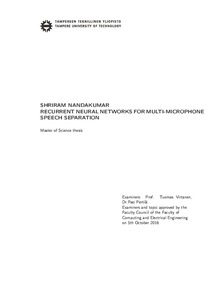Recurrent neural networks for multi-microphone speech separation
Nandakumar, Shriram (2018)
Nandakumar, Shriram
2018
Information Technology
Tieto- ja sähkötekniikan tiedekunta - Faculty of Computing and Electrical Engineering
This publication is copyrighted. You may download, display and print it for Your own personal use. Commercial use is prohibited.
Hyväksymispäivämäärä
2018-01-10
Julkaisun pysyvä osoite on
https://urn.fi/URN:NBN:fi:tty-201801031010
https://urn.fi/URN:NBN:fi:tty-201801031010
Tiivistelmä
This thesis takes the classical signal processing problem of separating the speech of a target speaker from a real-world audio recording containing noise, background interference — from competing speech or other non-speech sources —, and reverberation, and seeks data-driven solutions based on supervised learning methods, particularly recurrent neural networks (RNNs). Such speech separation methods can inject robustness in automatic speech recognition (ASR) systems and have been an active area of research for the past two decades. We particularly focus on applications where multi-channel recordings are available.
Stand-alone beamformers cannot simultaneously suppress diffuse-noise and protect the desired signal from any distortions. Post-filters complement the beamformers in obtaining the minimum mean squared error (MMSE) estimate of the desired signal. Time-frequency (TF) masking — a method having roots in computational auditory scene analysis (CASA) — is a suitable candidate for post-filtering, but the challenge lies in estimating the TF masks. The use of RNNs — in particular the bi-directional long short-term memory (BLSTM) architecture — as a post-filter estimating TF masks for a delay-and-sum beamformer (DSB) — using magnitude spectral and phase-based features — is proposed.
The data—recorded in 4 challenging realistic environments—from the CHiME-3 challenge is used. Two different TF masks — Wiener filter and log-ratio — are identified as suitable targets for learning. The separated speech is evaluated based on objective speech intelligibility measures: short-term objective intelligibility (STOI) and frequency-weighted segmental SNR (fwSNR). The word error rates (WERs) as reported by the previous state-of-the-art ASR back-end — when fed with the test data of the CHiME-3 challenge — are interpreted against the objective scores for understanding the relationships of the latter with the former. Overall, a consistent improvement in the objective scores brought in by the RNNs is observed compared to that of feed-forward neural networks and a baseline MVDR beamformer.
Stand-alone beamformers cannot simultaneously suppress diffuse-noise and protect the desired signal from any distortions. Post-filters complement the beamformers in obtaining the minimum mean squared error (MMSE) estimate of the desired signal. Time-frequency (TF) masking — a method having roots in computational auditory scene analysis (CASA) — is a suitable candidate for post-filtering, but the challenge lies in estimating the TF masks. The use of RNNs — in particular the bi-directional long short-term memory (BLSTM) architecture — as a post-filter estimating TF masks for a delay-and-sum beamformer (DSB) — using magnitude spectral and phase-based features — is proposed.
The data—recorded in 4 challenging realistic environments—from the CHiME-3 challenge is used. Two different TF masks — Wiener filter and log-ratio — are identified as suitable targets for learning. The separated speech is evaluated based on objective speech intelligibility measures: short-term objective intelligibility (STOI) and frequency-weighted segmental SNR (fwSNR). The word error rates (WERs) as reported by the previous state-of-the-art ASR back-end — when fed with the test data of the CHiME-3 challenge — are interpreted against the objective scores for understanding the relationships of the latter with the former. Overall, a consistent improvement in the objective scores brought in by the RNNs is observed compared to that of feed-forward neural networks and a baseline MVDR beamformer.
